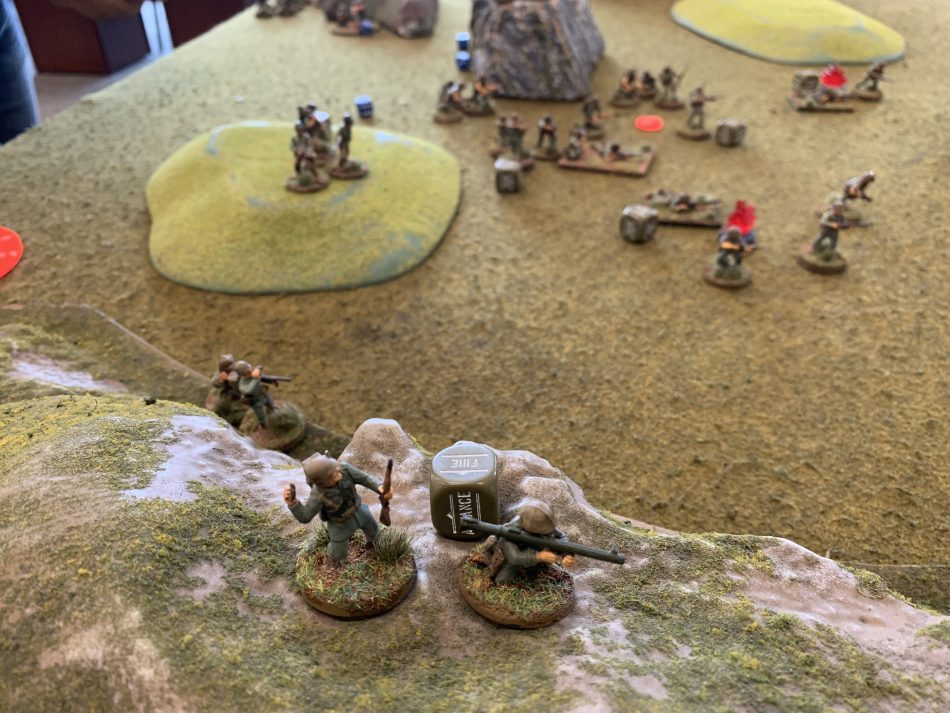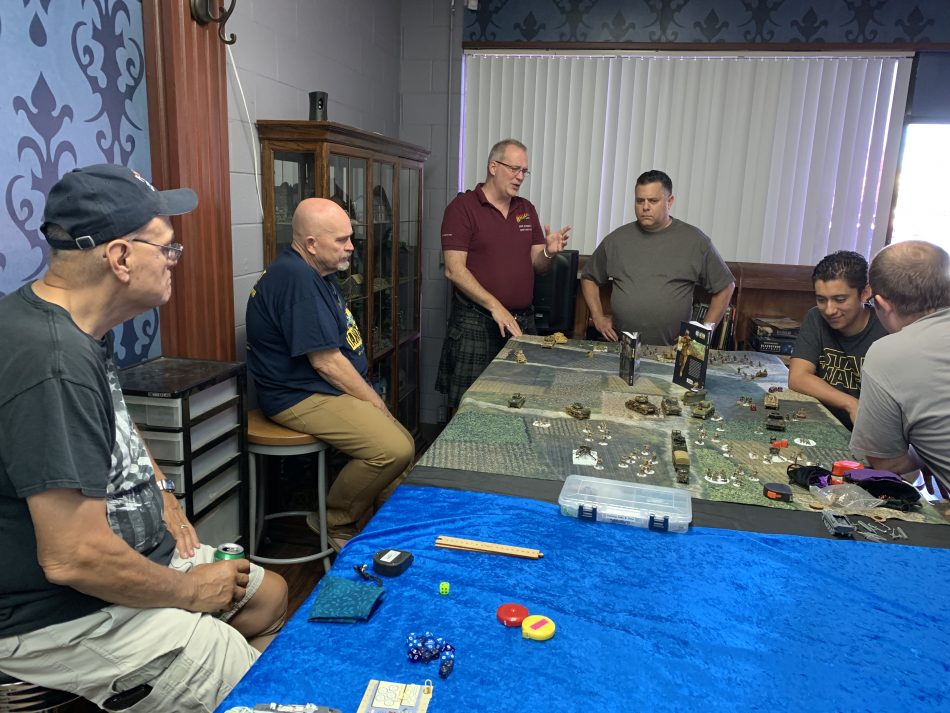Bolt Action Korea Kick Off
By Troy A. Hill
Southern California (SoCal) isn’t a location that often sees representatives of table-to gaming companies unless they’re homegrown. With major conventions like KublaCon in San Francisco and the Las Vegas Open (LVO) seven and five-hour drives away from the Los Angeles basin, SoCal often misses out on major hobby events.
That changed this week when the co-author of , and Warlord Games North American Demo Team grand-poobah Jon Russell paid SoCal a visit to launch the new Korean supplement and line of miniatures for Bolt Action.
Hosted by the (Pacific South West chapter), Russell visited three stores in the greater Los Angeles area Friday and Saturday, followed by a visit to San Diego in the extreme southern end of California.
I was on hand, to both cover the visit for NDNG, and to assist with running demos of Warlord games as needed. Along the way, I learned interesting facts about the game design process, and how the eventual Bolt Action Korea book came to be.
Known as “The Forgotten War,” for its position in between the major conflicts of World War II and the Vietnam era conflict, taking on Korea was no easy task. Russell shared the story many times over the weekend to various gamers and players who stopped by the stores to learn more.
“There is more here than can fit in one small book,” Russell explained. He relates how the research process, and sharing ideas with Paul Sawyer at Warlord HQ got Sawyer interested in the forgotten war.
“I’ve been pushing for Warlord to do Korea for three years,” Russell said. “Warlord gave us the go-ahead and told us 60,000 words. When we delivered the first manuscript, it went over like a lead balloon. Paul Sawyer said ‘Where’s the flavour and fluff?’ So we put the fluff back in, and we’ve got a book with more pages than the Bolt Action Rule Book.”
When asked about the process of writing the tome, Russell remarked that his co-author, Steve Smith, deserves credit for most of the rules and TOE list research.
“Warlord gave me the go-ahead, so I asked Steve if he wanted to help. He picked up the rugby ball and started running with it and I wasn’t about to trip him up. We had help from Leo Barron on two of the scenarios. I did the box-outs and the rest of the scenarios. Steve did the rest.”
John Harrel with the players from his first demo game, at Game Empire Pasadena.member and former president, US Army Major General (ret) John Harrel, was on hand Friday to run demo games at both , and at in Santa Clarita. He commented on how the Korea supplement moves Bolt Action into new gaming territory.
 “[Korea is] the best of the series so far,” Harrel said. “It picked up nuances like veteran sergeants. The platoon sergeants were often more important than a 2nd Lieutenant. In Korea that was especially pronounced. The NCOs in the US Army and the Marine Corps had more experience at the time. What these rules do is make the sergeants important. That little nuance made it much more realistic.”
“[Korea is] the best of the series so far,” Harrel said. “It picked up nuances like veteran sergeants. The platoon sergeants were often more important than a 2nd Lieutenant. In Korea that was especially pronounced. The NCOs in the US Army and the Marine Corps had more experience at the time. What these rules do is make the sergeants important. That little nuance made it much more realistic.”
Harrel selected Scenario Two: Comrade Ivan Needs Your Help! to demo and show the flavour the new forces bring to the game. He utilized his Soviet models to represent the communist Chinese, which faced off against US Marines. Both sides were attempting to locate and recover a pilot from a crashed MiG in the area. Since many of the UN pilots suspected that Russian pilots were flying missions over the battlefields, this would be an ideal time to prove their assessments. Harrel added a T-34 tank to the communist force and balanced it with an American Air Bombardment.
“Air Support is greatly improved. In normal BA, airstrikes don’t really affect tanks. They are much more effective in Korea,” Harrel added.
Jet aircraft have indeed been added to the game in the Korea supplement.
The damage they do and types of attacks have been changed to better reflect the advances in the strikes and ordinance. One of the biggest changes in airstrikes is the addition of Napalm. This nasty attack by planes acts as an HE attack, but targets may not go down to halve the hits. Napalm has a pen of +3, and does d3+2 pins when it hits. In an airstrike, it continues beyond the target unit 2d6 inches striking additional units.
“The new Korea book does a much better job of bringing the experience of the war into the game,” Harrel added. “You’re looking at Communist forces that have the ability to be really good. Unlike those Soviet squads we’re used to, [from WWII Bolt Action] the Chinese and North Koreans won’t be dying in droves.”
In both close-fought games, Harrel said the communist forces were victorious, though just barely.
“In the first game, the players were experienced with Bolt Action and understood the rules,” he said. “Unfortunately, during the second game, the airstrike came back on the US instead of hitting the tank. It created a lot of pins, but not much else, fortunately. However, the younger player in that game had a good grasp of fire and maneuver tactics despite his inexperience. I was coaching him [the US player] to use the new Staff Sergeant to keep the Snap-to going. That made a difference in maneuvering squads.”
Another addition, outside of the text of the Korea book is the inclusion of MiG Alley, which Mitch Reed has covered previously. Local gamer Phil Abramowitz was on hand to teach games of Blood Red Skies (BRS) with the new rules for jets. I sat down opposite our HMGS-PSW president Dana Hohn to learn BRS.
Dana Hohn (left), Phil Abramowitz (center), and NDNG Troy at the MIG Alley table.Hohn had never played BRS, though he has an extensive list of aerial combat games in his arsenal. I had tried BRS once before but hadn’t continued with it due to the lack of local players. At the end of the session, I wanted to grab the starter set. The game is both deceptively complex, and simple.
At the second session on Friday, General Harrel got to play BRS.
“Both games [Bolt Action and BRS] make it easy to be a force commander,” he added. “They recreate the feel of the war in a playable manner.”
I asked him what he thought about Blood Red Skies since he had experience playing other air combat games.
“Air games usually seemed overly-complicated… Warlord did a good job in condensing the 3D style of aerial combat into two dimensions. This game works really well to get someone into an air game.”
Russell added coaching to both sides as we played, helping us see the strategy behind game mechanics. Once I learned that the game is two-dimensional, with the angle of the planes on the stand representing “advantage” or “disadvantage” in relation to other pilots, the rules clicked into place for me.
“We released the MiG Alley set with pairs of planes,” Russell explained. “Some players wanted three planes per side in the box, but they didn’t fly in triples. They flew in pairs.” The new MiG Alley box gives players enough to “fly” the new forces if players already have the core BRS set. I’ve added the core set and MiG Alley to my wishlist.
“In general, the most noticeable change with the new rules,” Abramowitz said later, “is that it seems much harder to regain advantage once it is lost than with propeller planes.” The movement for the new jets is several inches longer than the prop-driven WWII planes in the core game.
MiG and Sabres from another manufacturer used to demo MiG Alley.On the second day of Russell’s visit, we visited my home store, Brookhurst Hobbies in Garden Grove, California. There, NDNG Jacob and I ran demos while Russell talked with players and signed the new books. The store sold out of the Korea books in the first hour.
I was able to run Cruel Seas, though I didn’t have any boats available to set up a Korean period scenario. Instead, I opted for an open ocean German vs US battle. Jacob did the same with a basic Bolt Action set up, due to a lack of Soviet figures to proxy for the PVA or Chinese.
Fortunately, Russell’s last store visit was Game Empire in San Diego. On his way south from Los Angeles, he stopped by the US Marine base, Camp Pendelton. A little known hero of the US side in the Korean conflict, Sgt. Reckless is memorialized there. She is one of Jon’s favourite special characters included in the book.
“She was one of the reasons we wrote the book,” he explained. “In the 50s everyone in the US knew who she was. The stories on her were pushed out and popular. When we were researching, we discovered her story and knew we had to include her. There will be a Sgt. Reckless model, so players with US forces can add her to the battle.”
The horse, bought by the 5th Marine Division, served as a pack animal, carrying ammo for a recoilless rifle platoon. During the battle for Outpost Vegas in March of 1953, she carried over 9,000 pounds of ammunition to the front lines and escorted or carried wounded back to the aid station.
“She would even walk between the wounded and the sound of artillery,” Russell explained, “to shield them from incoming fire.” She was wounded twice, herself, but continued making trips to resupply the marines on the front lines.
After the war, she was brought back to Camp Pendelton, was promoted to sergeant, and eventually staff sergeant.
You can watch a short video about .

